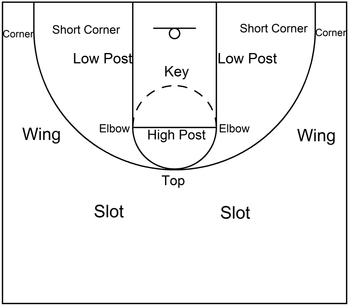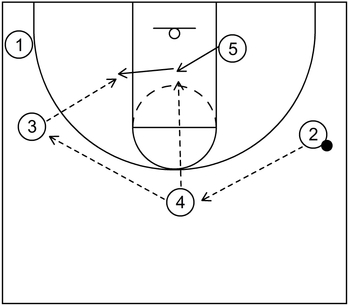What is the low post in basketball
The low post is an area of the basketball court that is near the basket, adjacent to a border of the key or paint known as a lane line, and below the border of the free throw line, also known as the high post elbow.

What are the low post blocks on a basketball court
The low post blocks can be typically viewed on a basketball court as filled rectangles that are adjacent to the lane lines and their primary purpose is to signify the general location of the low post areas.
From that point, a low post block can be utilized by players, specifically low post players, as a reference on where they should position themselves near the basket during offensive execution against a defensive team.
Generally speaking, low post players should try to position themselves outside of the lane lines above or at least slightly even with the low post block when their back is to the basket, particularly while being guarded by a low post defender.
If a low post player receives the ball above or at least slightly even with the low post block, then this will usually give the low post player the opportunity to execute a variety of low post moves towards the middle near the paint or towards the baseline of the court.
Conversely, if a low post player receives the ball below the low post block, then that same low post player will most likely find themselves either behind the basket or generally in a sub-optimal area near the basket.
If that occurs, this will more than likely become a boon for the defense as the low post player’s scoring options near the basket would probably be limited at best or non-existent at worst.
What is the difference between the low post and the high post
The most notable difference is that the low post is near the exterior of the paint slightly above the basket while the high post is the general area that surrounds one edge of the free throw line (i.e. the high post elbow) to the other edge.
Furthermore, most high post players will begin with their face towards the basket while most low post players will begin with their backs toward the basket.
What is a simple explanation of feeding the low post
Feeding the low post, also referred to as a post entry pass, consists of basketball offensive action in which a perimeter player in possession of the ball throws it to a low post player for potential scoring opportunities near the basket.
Generally speaking, prior to receiving the ball via a post feed, the low post player should establish position slightly above or directly on the low post block and raise one of the hands in the air as a target to receive the ball.
Afterwards, the perimeter player in possession of the ball could throw it to the low post player, typically via an air pass if feasible. Following that, the low post player could then attempt to score via low post moves near the basket.
It should also be noted that if a perimeter on-ball defender implements an above average amount of defensive pressure, particularly with high hands against the offensive perimeter player in possession of the ball, then that same offensive perimeter player could execute a fake pass up high before executing a bounce pass to the low post player if necessary.
Which defensive tactics could be used against offensive low post players
The defensive tactics known as the low post front or the double team could be used against a highly skilled offensive low post player to limit or prevent that same offensive player’s opportunities to score near the basket.
Low post front
The low post front, also referred to as fronting the post, is a defensive tactic that occurs before the low post player receives the ball and it can be used to deny an easy post entry pass.
General weakness to consider
It should be noted that the low post front could become susceptible to the post seal in which the offensive low post player executes a pivot turn to face the basket with the low post defender behind them.
Afterwards, the offensive low post player could receive the ball from a perimeter player, primarily by way of a lob pass over the top of the defender, and then score at the rim with a layup or dunk.
General techniques to front the post
Generally speaking, to front the post, the low post defender will position themselves between the offensive low post player and the perimeter player with the ball.
Additionally, the low post defender will extend an arm into the passing lane between the low post offensive player and the perimeter player.
By placing a hand in the passing lane, this will typically make it much harder for the low post player to easily receive the ball.
Also, at the same time, the perimeter player with the ball would have to throw a more challenging pass over the head of the low post defender to complete the post entry pass.
Furthermore, when fronting the post, the low post defender can execute the fronting stance on the high side (towards the half court) or on the low side (towards the baseline) of the offensive low post player.
The high or low side front could be determined by the location of the ball and/or by the skill sets and vulnerabilities of the offensive low post player.
As an example, if the ball is on the right side wing and/or the offensive low post player prefers to score with their right hand, then the low post defender could establish a low side front.
In that case, the low post defender would place their left side leg and left side extended arm between the offensive low post player and the perimeter player with the ball.
When that occurs, the low post defender is essentially influencing the offensive low post player to catch the ball with their left hand and try to score from the middle area.
From there, if the offensive low post player does attempt to score from the middle, then it might be tougher for that player to score with their non-dominant hand.
Low post double team
The low post double team is a defensive tactic in which the low post offensive player will receive simultaneous defensive pressure from the primary low post defender as well as a secondary defender.
General weakness to consider
The low post double team usually occurs after the offensive low post player receives the ball and because of that, it is generally vulnerable to an offensive player without the ball being left open, at least momentarily.
From that point, the low post player with the ball could pass it to the open offensive player who can then score or make plays for other teammates.
However, it should also be noted that this particular weakness could be diminished to a degree by establishing certain defensive rotations, especially with help defense from the weak side.
General techniques to double team the low post
Generally speaking, before establishing a low post double team, the offensive low post player should first receive the ball and dribble it at least one time.
After that, a secondary defender, preferably from the weak side of the court should move towards the offensive low post player and lock their feet together with the primary defender.
This basically prevents the low post player from being able to execute an escape dribble away from the double team action.
From that point, the primary and secondary defenders should use high hands without fouling against the offensive low post player.
The purpose of the high hands are to hinder the vision of the offensive low post player and increase the difficulty of that same post player to see possible passing options out of the double team.
From that point, the offensive low post player will usually execute one of three actions : turn the ball over, take a bad shot, or pass the ball to another teammate near the perimeter.
If the offensive low post player turns the ball over or takes a bad shot because of the double team, then this would be a beneficial outcome for the defensive team.
Moreover, even if the offensive low post player is able to pass the ball to another teammate, this could still be advantageous for the defensive team, especially if the offensive team prefers to score points via its low post players.
Affiliate Disclosure: I may earn a commission on qualifying purchases made through the links below.
What is an example of a low post basketball play
Part 1

This is a example of a simple low post basketball play that includes a wing post entry pass and a high low option for a potential scoring opportunity near the basket.
It is based on insights within Man-to-Man Side Ball Screen Offense with Quick Hitting Plays by Billy Donovan.
To begin, 2 cuts toward the right side wing to receive the ball from 1. After that, 1 cuts through to the left side corner while 3 fills the left side wing and 4 cuts to the top.
As that action happens, 5 could receive the ball from 2 via the wing post entry pass and score near the basket via low post moves if possible.
Part 2

If 5 is not able to receive the ball, possibly due to a low post front, 4 could receive the ball from 2. Next, 5 could duck into the lane, receive the ball from 4 via the high low action, and score near the basket via a low post move if feasible.
If 5 cannot receive the ball by way of high low action, then 3 could receive it from 4, which also completes ball reversal action.
After that, 5 could cut across the lane to the left side low post block, receive the ball from 3, and score near the rim with a low post move.
Which basketball offensive strategies are suitable for low post players
The 3 out 2 in motion offense is a basketball offensive strategy that seeks to create multiple scoring opportunities through the use of set plays as well as offensive actions such as basketball screens, basketball cuts, continuity patterns and pick and roll options among others.
The 4 out 1 in motion offense is a basketball offensive strategy that creates scoring opportunities via a variety of sequences such as basketball cuts, basketball screens, and dribble drive action.
The box offense is a basketball offensive strategy that utilizes quick hitting set plays with various basketball screens to create scoring opportunities near the basket or from the perimeter, particularly for the team’s best players.
The Hawk offense, also known as the Hawk set, is a unique basketball offensive strategy that utilizes high post action, a stack alignment, and various basketball screens to create scoring opportunities from the perimeter or near the basket for one or more players on the offensive team.
The Princeton offense is a basketball offensive strategy which utilizes the fundamental skills of cutting, dribbling, passing, screening, and shooting as well as three unique series of actions known as Chin, Low and Point to create scoring opportunities near the basket or from the perimeter.
The stack offense is a basketball offensive strategy that begins with a stack formation which also includes a variety of basketball screens to produce multiple scoring options for the offensive team’s best players.
The triangle offense is a basketball offensive strategy in which three players form a sideline triangle on one side of the court to create scoring opportunities via the use of various actions such as ball movement, basketball cuts, and basketball screens, primarily based on the reactions of the defense.